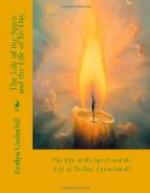In complete lives, the two things overlap: and so perfectly that no sharp distinction is made between the gifts of authority and of fresh experience. Traditional formulae, as we all know, are often used because they are found to tally with life, to light up dark corners of our own spirits and give names to experiences which we want to define. Ceremonial deeds are used to actualize free contacts with Reality. And we need not be surprised that they can do this; since tradition represents the crystallization, and handling on under symbols, of all the spiritual experiences of the race.
Therefore the man or woman of the Spirit will always accept and use some tradition; and unless he does so, he is not of much use to his fellow-men. He must not, then, be discredited on account of the symbolic system he adopts; but must be allowed to tell his news in his own way. We must not refuse to find reality within the Hindu’s account of his joyous life-giving communion with Ram, any more than we refuse to find it within the Christian’s description of his personal converse with Christ. We must not discredit the assurance which comes to the devout Buddhist who faithfully follows the Middle Way, or deny that Pagan sacramentalism was to its initiates a channel of grace. For all these are children of tradition, occupy a given place in the stream of history; and commonly they are better, not worse, for accepting this fact with all that it involves. And on the other hand, as we shall see when we come to discuss the laws of suggestion and the function of belief, the weight of tradition presses the loyal and humble soul which accepts it, to such an interpretation of its own spiritual intuitions as its Church, its creed, its environment give to it. Thus St. Catherine of Genoa, St. Teresa, even Ruysbroeck, are able to describe their intuitive communion with God in strictly Catholic terms; and by so doing renew, enrich and explicate the content of those terms for those who follow them. Those who could not harmonize their own vision of reality with the current formulae—Fox, Wesley or Blake, driven into opposition by the sterility of the contemporary Church—were forced to find elsewhere some tradition through which to maintain contact with the past. Fox found it in the Bible; Wesley in patristic Christianity. Even Blake’s prophetic system, when closely examined, is found to have many historic and Christian connections. And all these regarded themselves far less as bringers-in of novelty, than as restorers of lost truth. So we must be prepared to discriminate the element of novelty from the element of stability; the reality of the intuition, the curve of growth, the moral situation, from the traditional and often symbolic language in which it is given to us. The comparative method helps us towards this; and is thus not, as some would pretend, the servant of scepticism, but rightly used the revealer of the Spirit of Life in its variety of gifts. In this connection we might remember that




